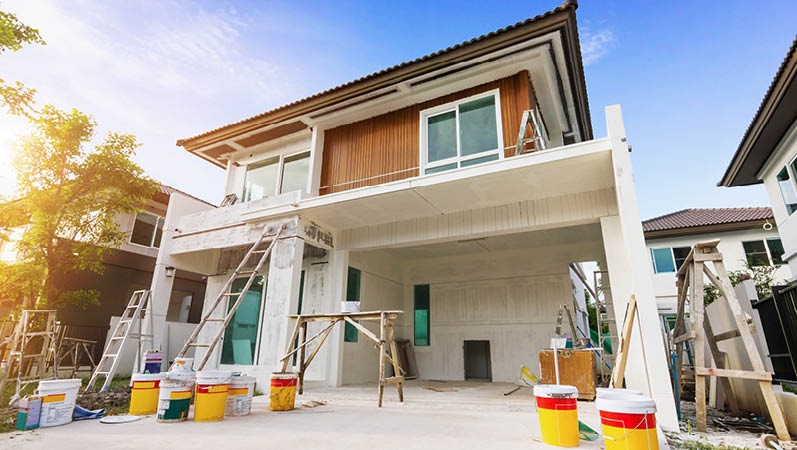Residential Construction Costs in Colorado
Have you ever wondered what factors go into the cost of building a home in Colorado? Most people think about things like the size of the home and how fancy its finishes are, but they don’t think about the home’s shape or the style of its roof. Overall, construction quality is the biggest factor that influences the cost to build a home. But construction quality probably includes more factors than you realize.
What Affects the Cost to Build a New Home?
The 2020 National Building Cost Manual provides construction costs for residential buildings. It factors in everything from labor, materials, equipment and plans, to building permits, supervision, overhead and profit. It does not include the cost of land, site development, or government fees (other than building permits).
Regardless of location, the most expensive components of a new home are these:
- Wall framing and exterior finishes: 14%
- Floor structure: 12%
- Plumbing: 12%
- Electrical system: 10%
- Roof: 10%
- Foundation: 9%
- Interior wall and ceiling finish: 8%
- Kitchen detail: 8%
Together, they make up about 83 percent of a new home’s construction cost. In other words, if you were constructing a $400,000 home (remember, construction costs don’t include land prices), here’s how much the most expensive parts would cost:
- Wall framing and exterior finishes: $56,000
- Floor structure: $48,000
- Plumbing: $48,000
- Electrical system: $40,000
- Roof: $40,000
- Foundation: $36,000
- Interior wall and ceiling finish: $32,000
- Kitchen detail: $32,000
- Total: $332,000
Interesting, right? It turns out that most of the things that entice homebuyers when they’re shopping, such as floor finishes, interior details, bath details and special features (including appliances), each make up less than 5 percent of a home’s construction costs.
Location-Specific Residential Construction Costs
What factors affect construction costs by location? According to the guide, labor, equipment and material costs, as well as labor productivity, job conditions and markup, are the key factors. We’ve seen some of these play out in Denver, which has suffered from too little supply in the housing market and too few workers to ramp up construction.
Also, when bad weather causes delays, requires snow removal, adds worksite heating costs and leads to overtime work, construction costs can increase. One option that adds costs but can limit delays is building tents over construction sites to protect against the elements. By contrast, during a warm, dry winter, builders can work on projects that aren’t possible when it’s snowing, and as a result, homes are completed on time or ahead of schedule.
The manual also has a table showing how construction costs in 600 North American communities vary. For example, costs are 37 percent above average in Boston and 14 percent below average in Greenville, Miss. In Denver, construction costs are 1percent above average and Colorado, as a whole, is posting costs just 1 percent above average according to the manual’s 2020 edition.
For comparison, costs are 9 percent above average in California, 20 percent above average in Hawaii and 9 percent below average in Idaho. Within Colorado, it’s relatively more expensive to build in Denver and Aurora; it’s relatively less expensive to build in Salida and Pagosa Springs.
How Home Features Affect Construction Costs
Unless you’ve built a home before, you’ve probably never thought about this but a square home with four corners is less expensive to build than an L-shaped home with six corners or an irregularly shaped home with 10 or more corners. That’s why affordable suburban tract homes tend to be boxy while custom mansions often come in unique shapes. Also, building a tract home in a new suburb tends to cost less than building a custom home in a well-developed city.
Larger homes cost more to build overall but can be more economical per square foot than smaller homes. A basement or second story is an especially economical way to add square footage. A two-story home doesn’t require any more land, grading or foundation than a one-story home. Speaking of grading, a flat lot is easier and less expensive to build on than one with grade changes, like a mountainside home.
Large, windows, skylights and doors with architectural features increase cost. So does a multi-pitch roof, where different sections of the roof come together at different angles, as compared to a simple dual pitch roof. A high number of plumbing and light fixtures can also increase costs. As you might remember from the list above, plumbing and electrical are two of the more expensive components of new construction.
Construction Cost Challenges
One of the challenges to Denver’s affordable housing shortage is that it can cost more to build a new home than what lower-income families can afford. Another challenge is that builders’ insurance premiums have been pushed up by construction defect lawsuits, and some of those increased costs inevitably get passed on to homebuyers.
When construction costs are high, as they have been in Colorado for the last several years, builders see more benefits from constructing larger, more expensive properties that are more efficient to put up and turn a greater profit at sale. Other factors that affect residential construction costs in Colorado include the cost of raw land, the cost to develop the land, high lumber prices, construction labor shortages, and government fees for development and construction.
Conclusion
Last year, the Denver area was enjoying an increase of about 13,000 new homes per year. But once COVID-19 hit, Denver saw a 12 percent drop in residential housing unit permits and starts in April 2020 compared to the previous year. However, based on the latest data from U.S. Census Bureau, home building activity surged in July, up 22 percent from the previous month and 23 percent from the same time last year.
If you’re looking to buy a new construction home in Denver or the surrounding area, our brokers can help. Whether you’re looking for a house, condo, townhome—or even a new apartment to rent—let us take the pressure off of finding the best listings for you in this tight housing market.
(Editor’s note: This article was originally published in April of 2019. It has been edited and updated to provide current information and trends).




